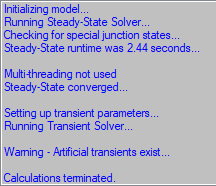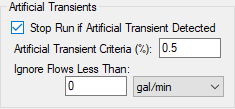Artificial Transient Detection Panel
Artificial Transients are non-real fluid transients that occur when the steady-state results do not match the initial time step of the transient calculation. This mismatch will propagate an artificial wave through the system. If this Artificial Transient has significant magnitude and is not detected, it will interact with the real, physical transients being modeled and affect the results.
After the steady-state simulation has been completed, the results will be used as the initial conditions for the Method of Characteristics solution. To check for an Artificial Transient, the Method of Characteristics solution is allowed to proceed a single time step without any user transients applied. Because the system should remain at steady-state without any imposed transients, the results after this "zero time step computation" should not change.
The relative change in pressure and flow from steady-state to this "zero time step" is determined for each calculation station in the model. If any of these changes exceed the Artificial Transient Criteria, the simulation will be halted.

Figure 1: Halting of transient simulation when Artificial Transients are detected
Due to the nature of the changing calculation methods, it is possible that negligible differences between the two solutions will exist. While technically any difference no matter how small is an Artificial Transient, small differences are unavoidable in practice due to the differing solution methods. For this reason, the values are allowed to change within some tolerance. The Artificial Transient Detection panel provides several options to help troubleshoot and resolve artificial transients:
Note: See the Troubleshooting Artificial Transients topic for more information on how to change these settings appropriately.

Figure 2: Default Artificial Transient detection settings
-
Stop Run if Artificial Transient Detected - By default this option will be enabled, and Impulse will check for Artificial Transients and halt the transient solution if one is detected. This option to check for Artificial Transients can be disabled; however, the one and only reason for this option to be disabled is for troubleshooting the cause of an Artificial Transient. It should never be left disabled for non-troubleshooting simulations.
-
Artificial Transient Criteria (%) - The relative change that is considered small enough to ignore. For some models, it may be reasonable to increase this value. However, this depends in part on the nature of the Artificial Transient. In particular, it should be clear that allowing the Artificial Transient does not significantly impact the results before changing this value.
-
Ignore Flows Less Than - Extremely small changes in flow can still be relatively high on a relative basis. For this reason, there may be Artificial Transients that meet the Artificial Transient Criteria but still have very little impact on the model. If this occurs in the model, small flows can be ignored in the detection, allowing the calculation to proceed. Again, when modifying this value it should be clear that the results are not significantly affected.



